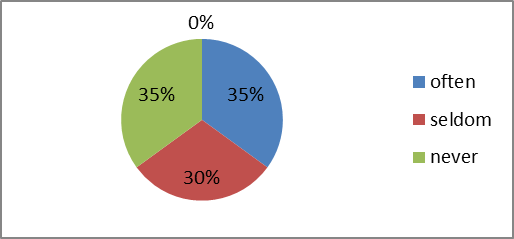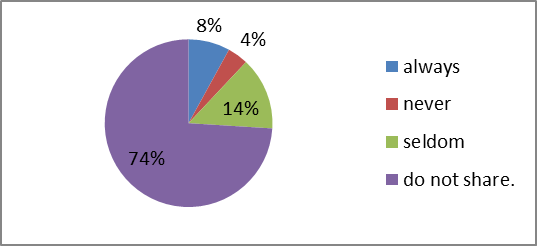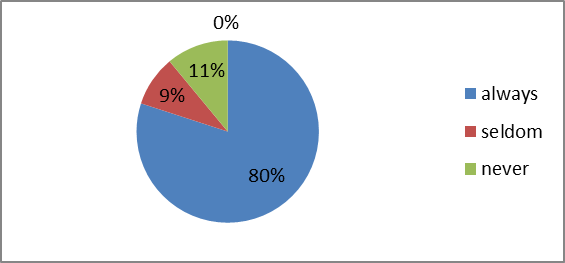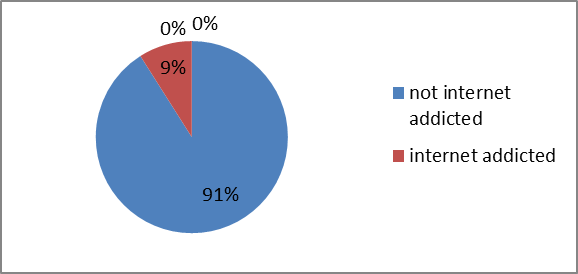Abstract
Cyberbullying is a relatively new but very relevant research topic in psychology abroad as well as in Russia. The problem of cyberbullying has arisen as a result of online communications (social media, emails and instant messages, online gaming, blogs, online diaries, video channels, etc.) that are extremely prevalent amongst today’s youth. The purpose of the article is to study the coping strategies of young people suffering from cyberbullying. The main methods of our research were theoretical analysis of psychological research literature and also empirical research methods with the use of psychodiagnostic methods (psychosocial questionnaire, developed by the Fund for the Internet Development; Kulakov’s test for assessing children’s internet addiction; Buss-Durkee Hostility Inventory; Lazarus’s questionnaire for assessing coping strategies), and methods of statistics data analysis. In this article we demonstrate that the intensity of cyberbullying is not determined by the amount of time spent by adolescents online and it does not depend on whether or not adolescents are addicted to the Internet. We found that adolescents affected by cyberbullying cannot effectively use appropriate copying strategies in order to overcome their online difficulties. Adolescents choosing non-adaptive coping strategies leads to the rise of their aggression levels. If adolescents seek help it can decrease the level of their physical and indirect aggression. The materials of this article represent practical value for specialists working with young people and interested in organising thematic sessions aimed at preventing cyberbullying among adolescents.
Keywords: Cyberbullyinginternet-bullyingaggressionpsychological bullyingsocial mediacoping strategies
Introduction
Today’s Russian society is characterised by the rising levels of various destructive conflicts, among which are cyberbullying (internet-bullying). From the psychological point of view cyberbullying is a specific type of psychological bullying which is performed through the use of online communication services and aimed at undermining people with systematic and intentional aggressive actions (Bochaver, Chlomov, 2014).
Lately, cyberbullying has been a very popular area for research all around the world.
The literature review allowed us to identify two main research types in this area.
The first type is associated with the analysis of possible cause of cyberbullying (psychological, social), the process of the formation of cyberbullying and its consequences (Slonje, 2017; den Hamer & Konijn, 2016; Wright, 2016; Remond et al, 2015; Carter, 2011; Heiman & Olenik-Shemesh, 2017). The analysis of the causes of cyberbullying taking into account age, gender and other characteristics has been researched by Slonje, Smith & Frisen (2017). Hamer & Konijn (2016) noted the link between emotional reactions of adolescents and the cyclical model of the cyberbullying. In Wright’s study (2016) it is shown that cyberbullying is more likely within the system of intimate intercommunication between adolescents. Remond et al. (2015) researched the mechanisms of dealing with and overcoming cyberbullying and noted the links with concurrent psychological pathologies. Carter (2011) studied the characteristics of the cyberbullying in adolescents living in urban and near-urban areas. Other research showed that students with visual impairments are more likely to be affected by cyberbullying due to the lack of social support (Heiman & Olenik-Shemesh, 2017).
The second type of research is devoted to the prevention of cyberbullying, to social and psychological support for victims of cyberbullying. The following authors have been working on this type of research: Cerna et al. (2016); Trnka & Martinkova (2016); DeSmet et al. (2016). Cerna et al. (2016) proposes an active parental involvement in the life of adolescents as an effective prevention mechanism. Trnka & Martinkova (2016) argue that constructive face-to-face communication is the most effective strategy to counter cyberbullying. DeSmet et al. (2016) underline the positive role of the third-party involvement (mediators) in dealing with cyberbullying.
In Russia the area of cyberbullying is being developed by the following authors: Soldatova et al., (2011, 2013, 2015); Zincova (2014); Cherkasenko (2015); Zotova (2011); Akimenko (2013); Bespalov (2010; Malkyna-Pyh (2010; Uganinova (2013).
Some authors are focused on studying positive and negative consequences of online activities (Baeva, 2011; Voyskunsky, 2010; Kondrashkin & Chlomov, 2013; Lebesheva, 2013; Shlapnikov, 2013; Blaya, 2012; Shipanova, 2013).
Baeva (2011) and Voyskunsky (2010) found that a personality can be negatively transformed under the influence of computer technologies. They note the following possible transformations: severe forms of computer games addiction, computer hacking, various online addictions, autism (isolation and aloofness, indifference to other people, apathy, inadequate perception and interpretation of one’s own actions, feelings, etc.), developmental disorders (Baeva, 2011; Voyskunsky & Dubovsky, 2012).
Soldatova (2011), Zotova (2011), Rasskazova (2013, 2014), Olkina (2015), Lebesheva (2013), Shlapnikov (2013) have conducted social and psychological studies aimed at identifying the attitudes of children towards the internet, they also examined the role of parents and teachers in fostering online safety and productive use of computer technologies amongst young people. The All-Russian social and psychological research project was conducted in collaboration with the Google company “The digital competency of adolescents and parents”. From 2011 the All-Russian research “Children of Russia online” has been conducted in 11 regions of Russia with the use of the same methodology as in the projects EU Kids Online II, “My safe net” and “the Internet through the eyes of school children” (Soldatova, 2011; Zotova, 2011; Rasskazova, 2013, 2014; Olkina, 2015; Lebesheva, 2013, and Shlapnikov, 2013).
Problem Statement
At present the area of cyberbullying is becoming more and more popular among specialists in various fields in view of the rising number of suicides and suicidal attempts among adolescents who suffer from online bullying.
Analysing the statistics of calls to a help line (as part of the All-Russian project “Children online”) allowed to range online risks depending on the importance of threats for children. The first places in this list take communicative (35% from the total amount) and technical threats (31% of calls). Next are content (14%) and users’ risks (11%) and also the obsessive internet usage (9%). The obtained results in conjunction with other research data lead authors to the conclusion that communicative risks represent the biggest threat on the internet (Soldatova, Zotova, 2011).
The results of the research project “Children of Russia online” show that 23% of young Internet users experience cyberbullying. The findings indicate that it is difficult to evaluate the dynamic nature of cyberbullying. The main reason for this is that adolescents are afraid to tell their parents what is happening to them when they go online.
Analysing literature lead us to believe that the nature of research in this area changes along with the development of the internet and the relevance of this issue keeps increasing. At present, it is not reasonable to say that the negative effects of the internet use on human development have been exhaustively researched. Moreover, there is a gap in the literature in the area of cyberbullying in relation to coping strategies of adolescents suffering from cyberbullying.
The aforementioned facts make it possible to draw the following conclusions:
There is a lack of effective prevention mechanisms in relation to cyberbullying despite the increasing use of the interment amongst adolescents both in Russia and in the world;
the number of cases of cyberbullying among adolescents is alarmingly high while teenagers exposed to the negative effects of the internet are not equipped with coping strategies.
With this in mind the main goal of this study was to investigate if there are any interconnections between the choice of coping strategies amongst adolescentы and the likelihood of them experiencing cyberbullying.
Research Questions
Research hypotheses
We had the following two hypotheses in this research: 1) adolescents suffering from cyberbullying are likely to use non-adaptive behaviour coping strategies; 2) adolescents who are significantly affected by cyberbullying demonstrate higher levels of aggression.
Research aims
Based on the research hypotheses this research set up the following aims:
To develop the structure of research, to form the sample of participants, to plan appropriate research methods.
To assess young people and divide them into group based on the frequency of their exposure to cyberbullying: group 1 – participants who often experience cyberbullying; group 2 – participants who rarely experience cyberbullying; group 3 – adolescents who never experienced cyberbullying.
To determine the degree of the internet addiction in the groups.
To compare the aggressiveness of young people in the groups.
To study coping strategies of adolescents.
To determine if there is any relation between coping strategies, the internet addiction and the aggression levels in the group.
Participants
Our study involved students (7-8th grades) of the IT lyceum of Kazan (Federal) University and State Russian and Tatar language school №111 in the Soviet area of Kazan. The total sample was 66 people. Among them were 14 female and 46 male adolescents (12-14 years old).
Stages of research
At the first stage of our research we assessed young people and divided them into group based on the frequency of their exposure to cyberbullying: group 1 – participants who often experience cyberbullying; group 2 – participants who rarely experience cyberbullying; group 3 – adolescents who never experienced cyberbullying. This was achieved with the use of the psychosocial questionnaire developed by the Fund for the Internet Development.
At the second stage we establsished the level of the internet addiction in the groups.
At the third stage the preferred coping strategies of the adolescent behaviour in difficult life situation were assessed as well as the level and the type of their aggression.
At the fourth stage the statistical data analysis of obtained results were performed.
Purpose of the Study
The purpose of the research was to determine the coping strategies of the adolescent behaviour affected by the internet-bullying (cyberbullying).
Research Methods
In the research were used following methods and techniques.
Discussion method was used to measure how many close contacts adolescents had with their peers and to help them develop closer relationships.
The empirical part of the research was performed with the use of the following methods:
-
Psychosocial questionnaire developed by the Fund for the Interned Development;
-
Assessment test to measure children’s internet addiction developed by S.A. Kulakov;
-
Buss-Durkee Hostility Inventory;
-
Lazarus’s questionnaire for assessing coping strategies.
Statistical data analysis
-
The calculation of means and standard deviations;
-
t-tests for dependent variables;
-
Pearson’s correlation.
Findings
The analysis of the frequency of cyberbullying among adolescents
We have identified the following three groups of adolescents based on the frequency of cyberbullying experiences. The first group (often experience cyberbullying) included 23 adolescents (35%), the second group (seldom experience cyberbullying) – 20 adolescents (30%), the third group (have never experienced cyberbullying) – 23 adolescents (Figure

We found that the likelihood of adolescents experiencing cyberbullying does not relate to the amount of time they spend online. Decreasing the amount of time spent online does not necessarily prevents the youth from cyberbullying.
It was found that 74% of children share with parents what they do on the internet (figure

8% of adolescents share their experiences with their parents, 4% of adolescents sometime share this information with their parents and 14% of adolescents seldom talk to their parents on this topic. A very high proportion of adolescents (74%) do not tell anything to their parent (this could be attributed to the specificity of the teenage period, young people often wish to be independent and make their own decisions without parents’ advice).
More often online bullies hack social media accounts and emails of their victims. Having access to this information bullies can impersonate their victim online. In order to gain such access bullies need to know the telephone number of the victim and their e-mail.
To the question “How often do you give your contact details to strangers?” 80% of adolescents answered “often”, 9% of adolescents responded “seldom”, 11 % of adolescents – “never” (Figure

Being unaware of possible online threats and due to their age peculiarities, adolescents often do not know that this information can be used against them by cyberbullies. The desire to become leaders and to gain positive reputation among their peers often clouds the judgement of teenagers and they do not consider possible consequences of sharing information about themselves. Moreover, adolescents often share their home address, the information regarding where they study, their personal photos and videos.
In view of the aforementioned points the cases of cyberbullying are very common. It is not possible to fight against cyberbullies for a teenager standing alone due to the number of psychological peculiarities of their age (they wish to make decisions on par with adults, they are anxious that their parents can take away their gadgets and cut them off the internet).
Studying online addiction among teenagers
The results of the assessment of the internet addiction has shown that adolescents who does not have internet addition are more likely to be suffer from cyberbullying (figure

The assessment of coping strategies of the behaviour, aggressive and violent reactions of adolescents in three groups of respondents.
To analyse the link between coping strategies, online addiction and the aggression levels in teenagers the Pearson’s regression coefficient (r) was used.
Adolescents affected by cyberbullying demonstrated the following:
Adolescents have serious addictions to distancing themselves from their reality which is correlated with the increased levels of suspicion and violence.
The more teenagers supress their emotions when experiencing cyberbullying, the more aggression they demonstrate in their behaviour.
Adolescents overcome psychological traumas by escaping into online realities where they can vent their pent up emotions and aggression.
The readiness of adolescents to risk and neglect their safety, failed attempts to change their situations as well as to prevent negative situations from happening relate to the increase of the verbal and physical aggression manifested through fights, verbal abuse, etc.
The immature behaviour of adolescents can lead to the decline of the cyber bullying and the rise of aggression level.
The physical aggression in adolescents may be reduced when adolescents ask for help of their parents or other people.
For adolescents that are rare affected by the cyberbullying the following features are in common:
Destructive, aggressive ways of the change of the situation in adolescents that is associated with the increased level of negativism and the umbrage.
The suppression of emotions by adolescents affected by cyberbullying is associated with the increase of their violence and envy to others, hate and cautiousness.
The decrease of the value of psychotraumatic situations in adolescents can lead to the increase of their level of a physical aggression.
When those who are suffering from cyberbullying ask for help, they are less likely to demonstrate aggression.
Adolescents who have never experienced cyberbullying can be characterised in the following way:
The burden of negative feelings associated with the cyberbullying decrease suspicion and rejection.
They do not hesitate to ask for help in the difficult situations.
They can stand up to adversity, they are prepared to be active and engage in real-life actions when facing difficult life situations.
They rarely use physical violence against other people and rarely envy and hate others for real and virtual actions.
To sum up (1) cyberbullying is not determined by the amount of time spent by adolescents online and it is not related to any online addictions. (2) Adolescents affected by cyberbullying are unable to use effective coping strategies and do not know how to overcome their problems. (3) The victims of cyberbullying often use non-adaptive coping strategies in comparison to those who have never experienced cyberbullying. (4) The use of non-adaptive coping strategies leads to the increased levels of their aggression. (5) Being able to ask for help can decrease the level of physical and non-direct aggression.
Conclusion
At present the problem of cyberbullying is taking up a significant role among communication risks. The most vulnerable group of victims affected by cyberbullying are adolescents. The peculiarities of adolescence make this group of people not being able to defend themselves from online bullies. As a result adolescents experience not only psychological traumas but they can also become exposed to physical threats.
The cases of suicides because of online bullying among adolescents increase every year. Often children are not aware of ways to cope with difficult life situations, they are afraid of asking for a help from adults and experience stress, anxiety and fear.
The results of the research have led us to the conclusion that there is no direct link between cyberbullying and internet addictions. This has also been confirmed by the data collected by the Fund for the Internet Development. This means that small amounts of time spent online does not prevents children from becoming victims of online bullies.
Moreover, our findings demonstrate that adolescents affected by cyberbullying are likely to choose non-adaptive coping strategies.
Due to the peculiarities of cuberbullying adolescents cannot determine and choose most effective coping strategies and ways to overcome their difficulties. Because the set of coping abilities is a continuously changing cognitive and behavioural personal entity, adolescents suffering from cyberbullying cannot choose adaptive coping strategies.
Adolescents who are facing cyberbullying often use their cognitive abilities to distance themselves from unpleasant situations, they deny and underestimate their significance, they try to regulate their feelings and actions, do everything to escape the problem and avoid solving it. They deny and hide from their parents the fact that they are being bullied. Opting for this type of coping strategies leads to the increased levels of aggression.
The aggressive behaviour stems from the inability to overcome difficult life situations. When facing difficulties adolescents often prefer to escape to online worlds and vent their aggression there. One of the peculiarity of cyberbullying as a communication risk is the leading role in communication is always taken by the bully. They have influence over their victim intimidating them and applying psychological pressure. This leads to frustration in the victim who is unable to choose adaptive behavioural strategies.
Thus the hypotheses of the research were confirmed.
The obtained results of the research can be used for prevention of cyberbullying among adolescents and school children. Also, the understanding of the relation between the choice of coping strategies of adolescents and their levels of aggression can lead to solution of many problems associated with the diagnostics of psychological conditions, psychological consultation and psychocorrection of adolescents and also for psycho-pedagogical work with parents.
At present, the studies on this topic confirm the relevance of the problem and the need for further analysis of the situation. The prevention and investigation of cyberbullying cannot be made using traditional methods. It is important to take on boar the individual peculiarities of adolescents by using psychological analysis and the assessment of every individual case of cyberbullying. We recommend that the preparation of psychologists should involve the investigation of the cases of cyberbullying, analysing the role of its participants and the spread of cyberbullying in schools among primary school children, secondary school children, high school children and college students.
Acknowledgements
The work is performed according to the Russian Government Program of Competitive Growth of Kazan Federal University.
References
- Akimenko, А.К. (2013). Strategies of the adaptive behaviour of the student’s youth and their characteristics// Izv. Satarov university Nov. ser. Set. Akmeology of education. Psychology of development. 2 (1): 63-74.
- Baeva, I.A. (2011). Psychological safety of the educational environment: the personal development: monography under edition of I.A.Baeva. V: SPb.: NestorHistory, 272.
- Bespalov, E.I. (2010). The results of the online research “The young internet user” in 2010. Available online at: http://www.friendlyrunet.ru/files/281/110530-otchet.pdf
- Bochaver, A.A. & Chlomov, K.D. (2014). Bullying as an object of the research nd the cultural phenomenon. Psychology. The journal of the higher school of economy, 10(3): 149–159.
- Bochaver, A.A. & Chlomov, K.D. (2014). Cyberbullying: the bullying in the environment of modern technologies. The journal of the higher school of economy. 3: 177 – 191.
- Cerna, A., Machackova, H. & Dedkova, L. (2016). Whom to Trust: The Role of Mediation and Perceived Harm in Support Seeking by Cyberbullying Victims. Children & society, 30 (4), 265-277. DOI:
- Cherkasenko, O.S. (2015). The phenomenon of the cyberbullying in the adolescent period. The personality, family and society: questions of the pedagogics and the psychology. 6: 91–94.
- Cherkasenko, O.S. (2015). The social net as a type of the surrogate communication. The questions of the pedagogics and the psychology. 3: 138—141.
- den Hamer, A. H. & Konijn, E. A. (2016). Can emotion regulation serve as a tool in combating cyberbullying? Personality and individual differences, 102, 1-6. DOI:
- DeSmet, A., Bastiaensens, S., Van Cleemput, K., Poels,K., Vandebosch, H., Cardon, G. & De Bourdeaudhuij, I. (2016). Deciding whether to look after them, to like it, or leave it: A multidimensional analysis of predictors of positive and negative bystander behavior in cyberbullying among adolescents. Computers in human behavior, 57, 398-415. DOI: 10.1016/j.chb.2015.12.051.
- Heiman, T. & Olenik-Shemesh, D. (2017). Cyberbullying Involvement of Adolescents with Low Vision Compared to Typical Adolescents, as Related to Perceived Social Support. Journal of aggression maltreatment & trauma, 26 (2), 105-115. DOI:
- Kondrashkin, A.V. & Chlomov, K.D. (2012). Deviant behaviour of adolescents in the Internet: the change of the social situation. Psychology, Journal of the higher school of economics, 9(3): 102–113.
- Malkyna-Pyh, I.G. (2010). Viktimology: psychology of the behaviour of the victim, M.: Eksmo, 864.
- Remond, J., Kern, L . & Romo, L. (2015). A cyberbullying study: Analysis of cyberbullying, comorbidities and coping mechanisms. Encephale-revue de psychiatrie clinique biologique et therapeutique, 41 (4), 287-294. DOI: 10.1016/j.encep.2014.08.003ю.
- Shipanova, D.E. (2013). Mobbing in the educational environment. The thesis manual Sworld. 23 (4): 64-69.
- Slonje, R., Smith, PK. & Frisen, A. (2017). Perceived reasons for the negative impact of cyberbullying and traditional bullying. European journal of developmental psychology, 14 (3), 295-310. DOI:
- Soldativa, G. & Olkina, O. (2015). Minuses of the openness. Children in the informational society. 20: 26—47.
- Soldativa, G.U. (2013). The digital competency of adolescents and parents: results of the All-Russian research. M.: Fond of the Internet Development, 144.
- Soldatova, G. & Rasskazova, E. (2013). The excessive use of the internet: factors and signs. Psychological journal, 34 (4): 105—114.
- Soldatova, G. & Rasskazova, E. (2014). The safety of adolescents in the Internet: risks, coping and the parents’ meditation. The national psychological journal, 3 (15): 39—51.
- Soldatova, G., Zotova, E., Lebesheva, M. & Shlapnikov, V.M. (2013). Internet: the abilities, competencies, safety. Methodical materials for the workers of the system of the common education. M.: Google, 165.
- Soldatova, G.V. & Zotova, E.U. (2011). The risk zone: Russian and European school children: problems of the online socialisation. Results of the research “Childrne of Russia online”. Available online at: http://detionline.com/assets/files/journal/7/ 12research_7.pdf.
- Soldatova, G.V., Shlapnikov, V.N. & Gurina, M.A. (2015). The evolution of the online risks: the results of the five-year help line “Children online”. The Consultative psychology and psychotherapy journal, 3: 65.
- Trnka, R., Martinkova, Z. & Tavel, P. (2016). An integrative review of coping related to problematic computer use in adolescence. International journal of public health, 61 (3), 317-327. DOI:
- Uganinova, E.R. (2013). Internet as a new space of the self-realisation of the youth. The review. OGU. 7 (156): 82–89.
- Voyskunsky, A.E. (2010). Psychology and internet. M.: Akropol.
- Voyskunsky, A.E. & Dubovsky, L.M. (2012). The human in the information society: the scientific thesises. Pensa: PGPU named after V.G.Belinsky, 59-64.
- Wright, M. F. (2016). Cybervictims' emotional responses, attributions, and coping strategies for cyber victimization: a qualitative approach. Safer communities, 15 (3), 160-169. DOI:
- Zincova, A.S. (2014). Social prevention of the cyberbullying / A.S.Zincova // The review of the Nizhnynovgorod university named after Lobachev. The series: Social sciences, 3: 122–128.
Copyright information

This work is licensed under a Creative Commons Attribution-NonCommercial-NoDerivatives 4.0 International License.
About this article
Publication Date
31 August 2017
Article Doi
eBook ISBN
978-1-80296-028-0
Publisher
Future Academy
Volume
29
Print ISBN (optional)
-
Edition Number
1st Edition
Pages
1-960
Subjects
Teacher, teacher training, teaching skills, teaching techniques
Cite this article as:
Minullina, A. F., Pyrkova, K. V., & Valiullina, G. V. (2017). Copying Strategies Of Adolescent Behaviour In Cases Of Internet-Spam (Cyberbullying). In R. Valeeva (Ed.), Teacher Education - IFTE 2017, vol 29. European Proceedings of Social and Behavioural Sciences (pp. 527-535). Future Academy. https://doi.org/10.15405/epsbs.2017.08.02.61

